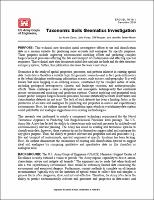Please use this identifier to cite or link to this item:
https://hdl.handle.net/11681/31458Full metadata record
| DC Field | Value | Language |
|---|---|---|
| dc.contributor.author | Davis, Austin V. | - |
| dc.contributor.author | Furey, John S. | - |
| dc.contributor.author | Morgan, Cliff | - |
| dc.contributor.author | Seiter-Moser, Jennifer M. | - |
| dc.date.accessioned | 2019-01-24T14:49:22Z | - |
| dc.date.available | 2019-01-24T14:49:22Z | - |
| dc.date.issued | 2018-12 | - |
| dc.identifier.govdoc | ERDC/EL TN-18-1 | - |
| dc.identifier.uri | http://hdl.handle.net/11681/31458 | - |
| dc.identifier.uri | http://dx.doi.org/10.21079/11681/31458 | - |
| dc.description | Technical Note | - |
| dc.description.abstract | This technical note describes initial investigative efforts to use soil classification data in a manner suitable for producing more accurate soil analogues for specific purposes. Those purposes include improving environmental modeling efforts and predicting complex biogeochemical processes affecting the fate and transport of contaminants and affecting spectral responses. This technical note also documents initial data analysis methods and the data structure and query system; further, this publication discusses the team’s next steps. Geomatics is the study of spatial properties, processes, and patterns inherent in existing spatial data. Soils data is therefore a suitable topic for geomatic research—and in fact, pedo-informatics is the hybrid discipline synthesizing information science, soils science, and geography. It is well known that soils mapping is an evolving science, constrained by the complex nature of soils, including geological heterogeneity, climatic and landscape variation, and anthropomorphic effects. These challenges create a ubiquitous and inescapable heterogeneity that confounds precise environmental modeling and prediction systems. Current modeling and geospatial tools cannot predict complex biogeochemical processes, because statistically accurate multivariate soil characteristics datasets do not exist. The lack of such datasets has been a limiting factor in the production of accurate soil analogues for predicting soil properties in austere and expeditionary environments. Here, the authors discuss the foundation upon which an evolutionary data system could yield better soil analogue suggestions over existing methodologies. This research was performed to satisfy a component technology requirement for the Novel Taxonomic Approach to Predicting Soil Biogeochemical Processes work package. The U.S. Army (the Army) has lacked the ability to characterize soils and soil processes for militarily and environmentally relevant planning. The Army has relied on existing soil taxonomic systems to classify soils data; however, these systems do not by themselves suggest ideal soil analogues for any given purpose. Thus, the ability to predict relevant soil properties and soil processes (e.g., fate and transport of contaminants, spectral responses) at specific locations has been lacking. Here, the authors demonstrate the weaknesses of existing soil classification systems to suggest ideal soil analogues by comparing qualitative and quantitative data on like classified or analogous soils. | en_US |
| dc.description.sponsorship | Environmental Quality and Installations Research Program (U.S.) | en_US |
| dc.format.extent | 8 pages / 1.146 Mb | - |
| dc.format.medium | PDF/A | - |
| dc.language.iso | en_US | en_US |
| dc.publisher | Environmental Laboratory (U.S.) | en_US |
| dc.publisher | Engineer Research and Development Center (U.S.) | en_US |
| dc.relation.ispartofseries | Technical Note (Engineer Research and Development Center (U.S.)) ; no. ERDC/EL TN-18-1 | - |
| dc.rights | Approved for Public Release; Distribution is Unlimited | - |
| dc.source | This Digital Resource was created in Microsoft Word and Adobe Acrobat | - |
| dc.subject | Geomatic files | en_US |
| dc.subject | Soils--Classification | en_US |
| dc.title | Taxonomic soils geomatics investigation | en_US |
| dc.type | Report | en_US |
| Appears in Collections: | Technical Note | |
Files in This Item:
| File | Description | Size | Format | |
|---|---|---|---|---|
| ERDC-EL TN-18-1.pdf | 1.17 MB | Adobe PDF |  View/Open |